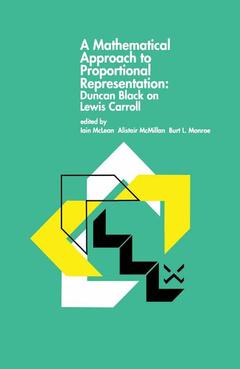Description
A Mathematical Approach to Proportional Representation: Duncan Black on Lewis Carroll, Softcover reprint of the original 1st ed. 1996
Coordinators: McLean Iain S., McMillan Alistair, Monroe Burt L.
Language: English
Subjects for A Mathematical Approach to Proportional Representation...:
Publication date: 09-2012
189 p. · 15.5x23.5 cm · Paperback
189 p. · 15.5x23.5 cm · Paperback
Description
/li>Contents
/li>
`This is a book about a well-known writer, Lewis Carroll, and about a little-known subject, the theory of voting' (from the Editors' Introduction).
This book has been edited from the manuscripts of the late Scottish economist Duncan Black. Shortly after the publication of The Theory of Committees and Elections Black started to collect material for papers and a book on Lewis Carroll's theory of proportional representation. Black's chapter plans made it clear that the book was to be in three parts, written by himself, followed by a reprint of Carroll's Principles of Parliamentary Representation and its main sources. Part I is biographical, introducing Lewis Carroll and giving relevant details of his life. Part II is Black's already published work on Lewis Carroll. Part III comprises the more detailed arguments about Carroll's reasoning, and Part IV contains reprints of rare original material on proportional representation by Carroll, James Garth Marshall, and Walter Baily. Taken together, the editors have provided a complete reference source for the theory of voting and proportional representation.
This book has been edited from the manuscripts of the late Scottish economist Duncan Black. Shortly after the publication of The Theory of Committees and Elections Black started to collect material for papers and a book on Lewis Carroll's theory of proportional representation. Black's chapter plans made it clear that the book was to be in three parts, written by himself, followed by a reprint of Carroll's Principles of Parliamentary Representation and its main sources. Part I is biographical, introducing Lewis Carroll and giving relevant details of his life. Part II is Black's already published work on Lewis Carroll. Part III comprises the more detailed arguments about Carroll's reasoning, and Part IV contains reprints of rare original material on proportional representation by Carroll, James Garth Marshall, and Walter Baily. Taken together, the editors have provided a complete reference source for the theory of voting and proportional representation.
Editors' Preface. Introduction. 1. What is the Theory of Voting? 2. Duncan Black and the Study of Theoretical Politics. 3. The Duncan Black Archive at the University of Glasgow. 4. Black's Struggles for Recognition. 5. Black and Lewis Carroll. 6. Carroll's Principles of Parliamentary Representation. 7. The Making of This Book. References for the Introduction. Part 1: The Life and Logic of Lewis Carroll. 1.1. Government by Logic. Part 2: The Principles of Parliamentary Representation. 2.1. An Outline of Carroll's Argument. 2.2. The Central Argument in The Principles of Parliamentary Representation. 2.3. Carroll and the Cambridge Mathematical School of PR: Arthur Cohen and Edith Denman. Part 3: An Analysis of Carroll's Argument. 3.1. Carroll's Scheme of Proportional Representation. 3.2. The Desiderata: In at the Deep End. 3.3. The Droop Quota in a Two- Party System. 3.4. The Representation of the Droop Quota. 3.5. Walter Baily and the Number of Voters Unrepresented. 3.6. J.G. Marshall and the Two-Person Zero-Sum Game. 3.7. Demand Curves, Maximin, and the d'Hondt Scheme of PR. 3.8. The Fourfold Table and Carroll's Quota, Q(s). 3.9. Carroll's Practical Scheme and the Single Transferable Vote. 3.10. Allocating Members to Districts. Part 4: Reprints of Original Material. 4.1. Lewis Carroll: The Principles of Parliamentary Representation, with Supplement and Postscript to Supplement. 4.2. James Garth Marshall: Minorities and Majorities; Their Relative Rights. 4.3. Walter Baily: Proportional Representation in Large Constituencies. Index.
© 2024 LAVOISIER S.A.S.

